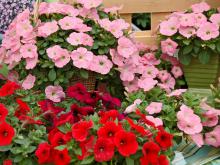Information Possibly Outdated
The information presented on this page was originally released on May 8, 2008. It may not be outdated, but please search our site for more current information. If you plan to quote or reference this information in a publication, please check with the Extension specialist or author before proceeding.
Petunias earn first place in containers
By Norman Winter
MSU Horticulturist
Central Mississippi Research & Extension Center
Since the invention of air conditioning, patios and decks have not seen as much entertaining and relaxing activities as they now are seeing. Along with outdoor cooking and eating, container gardening with petunias in decorative pots and lush hanging baskets is soaring in popularity.
You may be under the mistaken impression that a petunia is a petunia, but you had better get that out of your head because this terrific flower has changed. Check out just the names “Potunia,” “Surfinia” and “Supertunia,” and you will see they hardly sound like the same-ole, same-ole petunia.
Most growers are raving about the Potunia, and why not? With the world growing crazy for containers and baskets on the porch, patio or deck, it stands to reason that those petunias with a mounding habit and scores of flowers would be a hit.
I wanted to see personally how the Potunia had been holding up in trials, and there it was at the top of the University of Florida's list. The Potunia has been available in Pink, Neon and Deep Purple plus some mixes and is now available in dazzling new varieties Lobster and Dark Red.
Also among the leading contenders for hanging basket petunias are the Surfinias. Don't let the name throw you; these are quality petunias. The series is actually broken down now to Baby Surfinia, with eight colors; Baby Compact Surfinia, with six colors; Patio Surfinia, with seven colors; and regular Surfinia, which are the most trailing and feature 18 colors.
Then there are the Supertunias which feature more than a dozen colors. Some of my favorites are the Supertunia Vista Bubble Gum, Supertunia Cotton Candy and the Supertunia Bermuda Beach.
Many gardeners buy the baskets or containers already planted and ready to place in their preferred location. You have to admit this is easy, and when you see the prices, you will realize they are a good deal, too. If you are planting smaller petunias in containers or just wanting to repot them in a favorite old world-style urn, make sure your container drains well. Also, remember that the type of potting soil is an extremely important consideration. Select a fluffy, organic potting mix instead of one that is heavy and leads to poor drainage.
Petunias in containers or baskets will need to be fed regularly because as you apply water frequently, each dose leaches out nutrients. I like to use a diluted, water-soluble fertilizer every two weeks.
Don't be afraid to cut petunias back. In our trials, we normally do this to the petunias growing in raised beds. It seems that cutting back and adding a little fertilizer helps them survive August and look wonderful in the fall.
These new petunias are so packed with flowers that they definitely can dazzle all on their own. On the other hand, there are an almost limitless number of companions to consider, including other colors of petunias.
Because lime green is such a hot color, consider using blue or purple varieties with ornamental sweet potatoes. Use a taller grass or grass substitute like African iris as the thriller plant in the container with the petunias, which will both fill and spill. The sweet potato eventually will be the leading spiller, reaching downward as far as you let it.
Visit your garden center this weekend, and you will see that the petunia has changed. You just may find the hot Potunia, Surfinia or Supertunia, as well as the exciting new Shockwaves.




